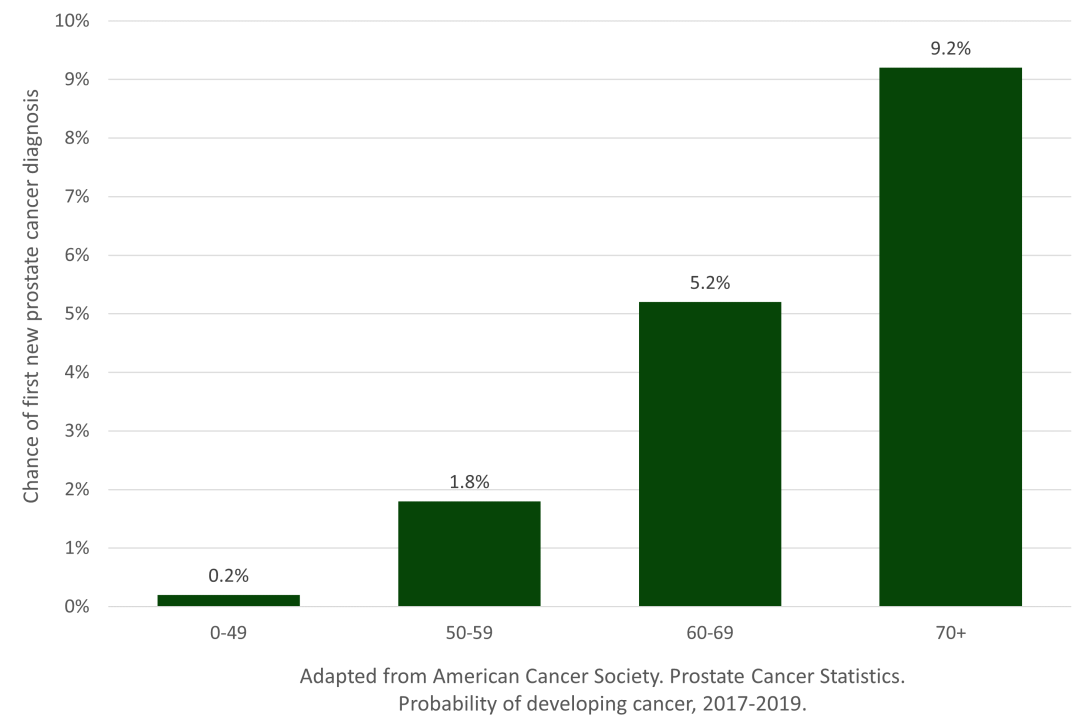Prostate Cancer FAQs
We answer your frequently asked questions about prostate cancer
Is prostate cancer common?
Chances are that you know someone besides yourself who has been diagnosed with prostate cancer.


Rates are higher among:
Veterans – 1 in 52
Black men – 1 in 63,4

AM I TOO YOUNG TO HAVE PROSTATE CANCER?
It is never too early to develop prostate cancer. While it is typically diagnosed in older men, especially those who are aged 50 years and up, younger men can still get prostate cancer5 and should consider asking their doctor to check their prostate-specific antigen (PSA) level from time to time.

Does prostate cancer run in families?
Prostate cancer can run in families, but not always.6 Having one or several male relatives with prostate cancer increases the risk, especially if that relative is your brother or father.6 This is known as a having a positive family history. It’s important therefore to get checked if you have a male relative with the disease.
Can women get prostate cancer?
To have prostate cancer you need to have a prostate. Women who were assigned female at birth and identify as women (cisgender) cannot get prostate cancer as they do not have a prostate gland. However, women who were assigned male at birth and identify as female (transgender) or who were born with both male and female sex organs (intersex) can get prostate cancer.7 The chances may be lowered by the use of feminizing hormones, but there is still a risk that should be discussed with a doctor if there any concerns.7
Are there prostate cancer symptoms?
Prostate cancer doesn’t often cause symptoms – it’s usually ‘asymptomatic’ and found by chance or routine screening.6,8
When there are symptoms these can be very general and can often be explained by having other conditions such as an enlarged prostate or bladder infection.6,8
General things you can look out for are:
- Difficulty or pain when passing urine6,8
- Erectile problems6,8
- Seeing blood in the urine or semen6,8
Other general symptoms of prostate cancer can include:
- Losing weight without good reason6
- Feeling very tired all the time6
- Having low iron levels in the blood6
- Feeling pain in your lower back or pelvic area6
It is important to see your doctor if you experience anything out of the ordinary. And, even if you don't have any of these symptoms, it's a good idea to visit your doctor regularly to talk about your prostate health.
What tests for prostate cancer might I need?
As well as asking about your medical and family history, there are several tests that can help your doctor determine if you have prostate cancer, see how far it has spread, and help you both decide what to do next.6
Tests can be used to screen for, diagnose and stage, or monitor prostate cancer, and include:6
- A digital rectal examination or DRE
- A prostate-specific antigen or PSA blood test
- A biopsy
- Prostate cancer imaging
- Genetic testing in some cases
What types or stages of prostate cancer are there?
Types and stages of prostate cancer are two different things. Type usually refers to the cell type involved, and stages generally refers to how far the cancer has spread within the body.
In terms of types, most prostate cancers are adenocarcinomas. These are so-called because they arise in the glandular tissue of the prostate. Other types of prostate cancer include small cell carcinomas, neuroendocrine tumors (NETs), transitional cell carcinomas and sarcomas.6
In terms of stages, prostate cancer can be very broadly separated into:6
- Localized prostate cancer
- Locally-advanced prostate cancer
- Advanced or metastatic prostate cancer
What is localized prostate cancer?
Localized prostate cancer means that the cancer is only seen in the prostate.9
This form of prostate cancer may not need any treatment at first, but if it does it is often very amenable to surgical removal or radiotherapy.9
What is locally-advanced prostate cancer?
Locally-advanced prostate cancer means that the cancer is no longer only found in the prostate, but that it has moved to areas that directly surround the prostate, such as neighboring lymph nodes.10
What is advanced or metastatic prostate cancer?
Advanced or metastatic prostate cancer means that the cancer has moved away from the prostate and spread into other areas of the body.11
What is metastasis?
Metastasis is the process by which cancer moves and spreads around the body. The first place prostate cancer tends to move or metastasize to is the lymph nodes and bones, but it can also move to nearby organs such as the liver and even reach the brain.11
When cancer occurs in several other places these are called metastases; you may also hear them referred to as ‘lesions’ or ‘mets.’11
Why is PSA testing for prostate cancer important?
PSA testing is important because it can be an early indicator of prostate cancer, especially as there aren’t often any other signs or symptoms of prostate cancer.
Getting a PSA test is one of the simplest things you can do to check your prostate’s health.
What is a normal PSA level?
Prior to definitive therapy a PSA of 4 (ng/mL) is considered to be within the normal range.6
My PSA is raised, do I have prostate cancer?
PSA can be raised for many reasons, not just because prostate cancer is present.
Although a PSA above 10 (ng/mL) is a strong indicator that there could be prostate cancer it is not always the case.6
A single raised PSA result does not mean that you have cancer. Additional PSA or other tests such as imaging may be needed to confirm a diagnosis.
What is a Gleason grade group?
The Gleason grading system was developed in the 1960s and can sometimes be misleading. Doctors have therefore revised how they use the Gleason score by referring to Grade Groups instead.6
There are five Gleason Grade Groups which give an indication of how quickly the prostate cancer may grow and spread, with the lower numbers suggesting slower growth and spread and the higher numbers indicating faster growth and spread.6
Using this approach Gleason scores of 6 and under fall into Gleason Grade Group 1 and Gleason scores of 9–10 fall into Gleason Grade Group 5.6
What is a Gleason score?
The Gleason score gives a measure of the severity of prostate cancer. It is determined by looking at samples of the prostate taken from biopsies, under the microscope.6
To get a Gleason score, the cells are first graded using a scale that goes from 1 to 5 to indicate how similar to normal cells the cells in the prostate sample look.6
The more normal the cells look, the lower the score (e.g., Gleason grade 1 or 2), but the less normal the cells look, the higher the score (e.g., Gleason grade 3, 4, or 5).6
To calculate the Gleason score at least two areas of prostate tissue needs to be looked at. Each area is individually graded and then the grades are added together.6
For example, if one area of cells is graded as 3 and another area is graded as 5, the score will by 8. This may be written down as 3 + 5 or 5 + 3. The first number indicates the grade of the most common cell type in the sample.6
The Gleason score may be used to categorize prostate cancer into one of three groups:6
- Low-grade, well differentiated prostate cancer (Gleason score 6 and lower)
- Intermediate-grade, moderately differentiated prostate cancer (Gleason score 7)
- High-grade, poorly differentiated prostate cancer (Gleason score 8–10)
Differentiated means how easy it is to identify or recognise prostate cells as prostate cells. So well differentiated means that you can make out that it is a prostate cell, poorly differentiated means that it is hard to tell if the cell is normal.
Can my prostate cancer be cured?
Prostate cancer is a very treatable type of cancer. If caught early enough, and before the cancer has spread to other parts of the body, it can also be highly ‘curable.’ 12
Rather than the word ‘cure,’ however, doctors tend to call the successful treatment of cancer as being in remission. This is because there is always a chance that the cancer can come back, which is called recurrence.13
The longer you are ‘cancer free,’ the greater the chances that your cancer may not return.13
Your doctor is the best person to ask about your long term outlook or prognosis, as this depends on many things including the type of prostate cancer you have, the Gleason score or grade, your PSA level, what your treatment options are, and also your general health.14
Even if you have metastatic disease, your prostate cancer can often be treated, and sometimes for a long period of time.6
Does my prostate cancer have to be treated?
Your doctor will discuss your treatment options with you.
Prostate cancer is generally not a fast-growing form of cancer, so you may not need to be treated immediately.6 If this is the case then your doctor is likely to suggest that you are still monitored regularly. This is called active surveillance.6
What prostate cancer treatments might be available to me?
There are many options for treating prostate cancer. Very generally, these include:6
- Surgery
- Radiation therapy which is also called radiotherapy
- Cryotherapy
- Hormone therapy
- Chemotherapy
- Immunotherapy
- Targeted drug therapy
Which is most suitable in your case will depend on where your cancer is located, how ‘active’ or ‘aggressive’ your prostate cancer is, whether this is your first experience of having prostate cancer or if you are experiencing a recurrence, and what your wishes are regarding your care.
How is localized prostate cancer treated?
Localized prostate cancer may be treated with surgery and radiotherapy, if it needs any treatment at all.9
How is locally-advanced prostate cancer treated?
Locally-advanced prostate cancer may be treated with radiotherapy, with or without additional hormone therapy. Surgery may also be an option for some men.10
How is metastatic prostate cancer treated?
Metastatic prostate cancer is generally treated with hormone therapy, which may be combined with chemotherapy.11
There may also be the opportunity to receive investigational new treatments for metastatic prostate cancer by enrolling in a clinical trial.11
What can I do to improve my prostate health?
Keeping yourself as healthy as possible is important whether or not you have been diagnosed with prostate cancer:
- Keep active
- Eat well
- Limit alcohol
- Quit smoking
- Get enough sleep
- Manage stress
- Know your PSA level
Trusted prostate cancer resources
Where to find further information on prostate cancer that you can trust
Start the discussion
Sign up for updates
We’ll be updating this website with new information on a regular basis so we hope you will check back with us again soon.
References
- American Cancer Society. Key statistics for prostate cancer. Accessed July 1, 2023.
- ZERO Prostate Cancer. Veterans and Prostate Cancer. Accessed July 1, 2023.
- Prostate Cancer Foundation. Additional Facts for Black Men and Their Families. Accessed July 1, 2023.
- ZERO Prostate Cancer. Black/African Americans and Prostate Cancer. Accessed July 1, 2023.
- American Cancer Society. Cancer Statistics. Prostate. Accessed September 30, 2023.
- American Cancer Society. Prostate Cancer. Accessed July 1, 2023.
- Prostate Cancer UK. Do trans women have a prostate? Accessed September 30, 2023.
- ZERO Prostate Cancer. What are the symptoms? Accessed July 1, 2023.
- Prostate Cancer UK. Localized prostate cancer [factsheet]. June 2022. Accessed September 30, 2023.
- Prostate Cancer UK. Locally-advanced prostate cancer [factsheet]. June 2022. Accessed September 30, 2023.
- Prostate Cancer UK. Advanced prostate cancer [factsheet]. May 2023. Accessed September 30, 2023.
- Cleveland Clinic. Prostate Cancer. Accessed September 30, 2023.
- American Cancer Society. Can cancer be cured? Accessed September 30, 2023.
- Prostate Cancer UK. What is my outlook? Accessed September 30, 2023.









